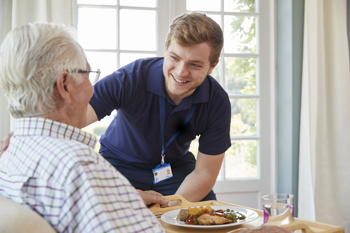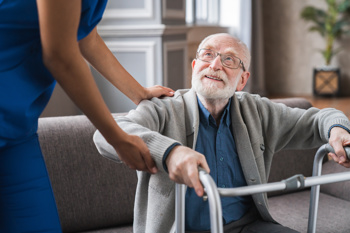Technology enabled care – The Best Examples
The digital future for technology enabled care is continuing to grow year on year, and with our current aging population it is imperative that local authorities help support the vulnerable people in their communities to be able to live more independent lives for as long as possible.
You might not be sure on the term technology enabled care, however you are more than likely going to be aware of some of the examples which are available, whether you have used them yourself or you have heard about them.
Examples of technology enabled care
- What is technology enabled care?
- Who is technology enabled care for?
- Why is technology enabled care important?
- Technology enabled care services – How can it be used to assess for risk?
- What challenges are there in providing technology enabled care?
- How can Access Assure help to provide the best technology enabled care?
- Summarising the best technology enabled care
The need for more sophisticated technology enabled care is crucial as more than 50% of older adults aged 65 and over in the UK are suffering with more than one chronic condition. Local authorities need to find a way to help people manage their conditions better.
For this to happen local authorities need to work closely with the Department of Health and NHS Digital to find the best examples to suit your community’s needs.
But, you may be wondering what technology enabled care is and why it is important? You might want to know what types of technology enabled care services best suit certain needs? Or you might just be intrigued to find out more information about technology enabled care in general to identify what your loved one could benefit from?
Whether you are an end-user or a local authority, we want to make sure at The Access Group you have the information you need to get the best outcomes from digital transforming the care vulnerable and older adults can receive remotely.
We are passionate about improving quality of life through increasing independence and providing positive reassurance by joining up data to provide better insights on individuals health and wellbeing.
In this article we will define what technology enabled care is, why it is important to people, their families and communities alike, as well as review what types of services best meet certain needs, to then explain how our Assure service can help provide the best technology enabled care for your local community.

What is technology enabled care?
Technology enabled care (TEC) is using technology to help monitor and manage individuals at risk to live longer, healthier and more independent lifestyles.
Technology enabled care follows a population health management approach where groups at risk are identified and supported with technology that best suits and manages their needs.
It refers to using telehealth, telemedicine, and telecare services to provide more convenient, accessible, and cost-effective care for a better continuity of care across the health and social care sector.
Who is technology enabled care for?
It is often thought that digital telecare and technology enabled care is only for elderly or older adults, when in reality it can help a wide range of people with a variety of different needs.
As TEC has developed over the years some examples and services have become more specialised for certain conditions, whereas others help make predictive decisions about future care needs through analysing an individual’s day to day life.
The complexity of technology enabled care can also differ depending on someone’s needs. In general most will be developed to be easy to use and some may be more subtle than others.
There are loads of examples where technology enabled care may be needed for a variety of at risk groups including:
- Providing safety outside of the home
- Fall prevention
- Reducing the risk of intruders
- Emergency help
- Prompts and reminders
- Accidental flooding
- Living conditions e.g. Carbon monoxide levels, house temperature, smoke detection
For all of these risks there will be different technology enabled care which is best. For example GPS devices and mobile alarms are useful in providing safety outside the home. Panic or community alarms are beneficial to reduce the risk of intruders and fall prevention. Sensors are great to detect movement and daily activities.
Keysafes allow caregivers and loved ones easy access if there is an emergency. Alarmed pill dispensers are great to use as prompts and reminders if an individual forgets to take their required medication. Finally, detectors are best used to improve the general living conditions for an individual and ensure their safety such as carbon monoxide and smoke detectors.
In general, technology enabled care can be for anyone at home who may be at risk and may need a bit more support. For example: older adults, individuals living with and trying to manage long-term conditions, individuals with mental health problems or learning difficulties, as well as patients which have recently discharged from hospital.

Download our guide to learn how Technology Enabled Care (TEC) works and how it aims to transform social care for the better.
Why is technology enabled care important?
Technology enabled care ultimately is important as it offers the opportunity for individuals to live more independent lives. TEC is also important for a number of different reasons:
1. Helps enable person-centred care
Through providing equipment which makes it easier to manage long-term conditions, build confidence in people’s mobility, and give a peace of mind for individuals and their families, adult social care technology enabled care can help reduce dependency on others, clinicians, and the NHS as a whole, and instead it can provide better person-centred care. This in turn, then brings together both the health and social care sector to deliver better joined up care across the care continuum.
2. Reduces GP attendance and hospital admissions
Through individuals learning how best to manage their conditions at home, risks are minimised to prevent something more serious taking place. Individuals have the opportunity to learn triggers and notice when their health is declining and know how best to react to it. This helps to reduce the reliance on the health sector as both hospital admissions and GP attendance can be reduced, and therefore this delays the need for residential care when waiting lists are already so long.
3. Cost-effective
Another reason why TEC is important is because it provides a cost-effective alternative for both local authorities and the NHS. Even though initial costs can be expensive the cost benefits experienced in the long-term, when technology enabled care is implemented correctly, can make it worth it.
According to the NHS around 9 million people get sent home from A and E each year after receiving advice they could have received from a pharmacist or 111. This is costing the NHS roughly £1.4 billion, not including the cost of ambulance call-outs. By local authorities commissioning and implementing technology enabled care, costs spent on emergency care, ambulance call outs and hospital admissions can be reduced. This in turn, can help reduce hospital discharge delays as less people will be admitted to hospital in the first place reducing waiting times in the hospital and the waiting times to be discharged. Technology enabled care can therefore provide the additional support needed to allow patients to recover at home safely and securely without having to rely on residential care.
4. More adaptable to change
Technology enabled care is also important is because it has the opportunity to continue to develop as the needs of an individual could change or get more complex. Here technology enabled care can have the functionality to adapt accordingly to help improve quality of life and show to the CQC how your local community is delivering the best continuity of care which encourages independence and safety ready for when the CQC inspects your local authority.
Technology is becoming more predictive through learning from its environment and a variety of data sources. Through continuous innovation we are slowly seeing how technology enabled care can help health crises be prevented through careful monitoring and intervention. Here technology enabled care can help support treatment, care plans, and reviewing to provide better digital connectivity with local authorities and clinicians, and help individuals be more self-serving and proactive with their own health.
Technology enabled care services – How can it be used to assess for risk?
Technology has always played an essential role in health sector where it has been heavily used around hospitals and acute care.
With the increased interest from both local government and the NHS to deliver more perosnalised, predictive, proactive and preventive care, it is now becoming the norm to use a range of apps, Internet of Things (IoTs), and technology to provide alerts, reminders, and remote monitoring.
Technology enabled care therefore helps go one step further. It helps to digitally transform the care delivery across local communities by using data insights to predict risks before they happen. This helps to ensure the support is in place when needed to make best use of the resources a local authority may have and further reduce the risk of hospital admission.
Here adult social care teams, telecare services, local authorities, and the NHS can join datasets together so proactive and preventative interventions can take place to mitigate further risks in the future. Through learning individual’s day-to-day patterns and behaviours, technology enabled care can set prompts and reminders to individuals to prevent any harm, pain, or discomfort taking place due to missed medications.
This helps individuals to transform their lives by having better opportunities to more personalised care and support so the need to move into residential care is delayed and prevented.

What challenges are there in providing technology enabled care?
In order to deliver the best technology enabled care services for your local community there are a variety of challenges to be aware of:
- Older adults can be more reluctant to using it
- Adults experiencing cognitive delays or confusion may struggle to use the devices
- Getting engagement from all stakeholders, families, and carers
- Mainstreaming the use of technology in a patient’s journey
- Ensuring all technology is up-to-date and being used to produce the best outcomes
- Ensuring you consider consent, privacy, and ethical considerations with every type of TEC an individual uses
In general one of the biggest challenges in general is providing telehealth to older adults . Some are reluctant due to being worried about their data or because they do not have the digital literacy to understand how the devices will work. A lot of these challenges can be easily overcome by being organised and aware of why end-users may struggle with different devices, and understand how best to support them.
One of the best ways to ensure outcomes are always having a positive impact on individuals is to review your technology enabled care regularly to see if any technological enhancements will provide better outcomes and make the user experience easier.
How can Access TEC help to provide the best technology enabled care?
In order for your local community to get the best outcomes we have three priorities in our technology enabled care service:
- Increase independence
- Provide positive reassurance to friends, family, and carers
- Join up data to provide better insights on the health and wellbeing of an individual
For these three priorities to be delivered we use both a proactive and preventative care approach for care planning, reviewing, and the care delivery.
What makes our Access TEC ecosystem go one step further in TEC world is that our insight ecosystem is data source agnostic and interoperable with 3rd party hardware. This allows all data and to be located onto one single platform (our HomeHub) to make it easier for end-users, their families, and clinicians alike to access the information they need when they need it.
Our technology enabled care devices learns the routines of each individual and can acknowledge their everyday behaviour in a matter of 14 days. This allows loved ones and caregivers to set up smart alerts in our Assure app and be notified with the alerts that matter to them.
Our latest integration with our care planning solution provides care workers visibility of smart alerts and alarms from the home hub in our mobile care planning app to enhance the activity information they have access to between visits. This, in turn, helps care workers know what has happened before their next visit to adapt care accordingly and identify issues before something more critical happens.
We are more than just a reactive alarm. In fact we bring together both reactive alarm functionality with digital monitoring tools to help improve individuals quality of life. Here our unobtrusive monitoring helps to build confidence and reduce dependency.
We make sure our TEC devices are easy to use for all so no one that needs it misses out. To ensure this happens we make sure that your digital switchover from analogue to digital telecare is smooth with minimal disruption.
Airtel Vodafone, one of our partners, found their end-users really benefitted from how quick and easy our devices were to install. In a matter of 25 minutes they were ready and set up and 95% of the self-funding end-users in Jersey were happy to switch over to our digital telecare straight away.
Summarising the best technology enabled care
In this article we have reviewed what technology enabled care is and why it is important for people, their families and the local community. We have addressed the benefits with clinicians and the NHS as a whole can experience as well as the reduced pressure on residential care.
Due to technology enabled care being so versatile we have acknowledged that different types can support different needs and different at risk groups. From this evaluation we have made it clear that technology enabled care can support more than the elderly and it can both independence and the reassurance needed.
We have highlighted the challenges in engaging all parties into using technology enabled care and how best to overcome them as well as explain how our Assure service goes one step further to provide the easiest way to digital monitor conditions, whilst being preventative and then reactive when an emergency arises.
We make it our aim to allow all vulnerable individuals to remain independent in their homes for as long as possible, but we understand how stressful it can be to make sure they are okay. We want to give everyone the opportunity and the freedom to do more so that individuals can monitored remotely whenever and wherever you are on our Assure app.
For more information on how we can provide you and your local community the best technology enabled care to increase independence, reduce dependency, and improve outcomes, ask your provider today to contact us, and we can demonstrate first hand just how easy and effective our technology enabled care is to use to create a better quality of life.

